新部落
I think, therefore I am. - René DescartesYears ago I read a book about the travel in Italy. As time goes by, the title and the author of the book all had faded away from my memory, but one comment about Tuscany strikes me so much that to this day I still remember. It says, “Tuscany is a place where people would feel inferior if they have not been there.” As much as I admire the unparalleled beauty of Tuscany, I thought the comment was a bit stretch.
Looking at these photos of European castles, as that particular remark about Tuscan comes to my mind, I do feel something “inferior,” and my ego, if any, is dwarfed: What images of grandeur, solemn and opulence! Not only as great miracles and quintessence in architecture, also and more important, these castles serve as epitomes of long-lasting European culture history, which in many aspects shapes the western civilization......
To name the post as ”神游“ is only because I have not been to those places yet. But, I would like to take a "cyber tour" first before I can go, in the hope that it at least offsets my feeling of "inferiority". So, here it goes.
In case anyone gets bored with those long captions, I have one of the most beautiful voices on the surface of this planet, Andrea Bocelli, to keep you waking up if you happen to fall sleep! : )))
Thank you for 神游 with me!
Neuschwanstein Castle - Munich, Germany
Neuschwanstein Castle (German: Schloß/Schloss Neuschwanstein, lit. New Swan Stone Castle) is a 19th century Bavarian castle. Located in Germany, near Hohenschwangau and Füssen in southwest Bavaria, the castle was built by Ludwig II, King of Bavaria, as a retreat and as an homage to Richard Wagner, the King's inspiring muse. It is the most photographed building in Germany, although photography of the interior is not permitted, and is one of Germany's most popular tourist destinations. King Ludwig II was a great nature-lover. His greatest concern was not to spoil the beauty of the surroundings by building Neuschwanstein Castle.

The conception of the castle was outlined by
Ludwig II in a letter to Richard Wagner, dated May 13, 1868;
"It is my intention to rebuild the old castle ruin at Hohenschwangau near the
Pollat Gorge in the authentic style of the old German knights' castles...the
location is the most beautiful one could find, holy and unapproachable, a worthy
temple for the divine friend who has brought salvation and true blessing to the
world."
The foundation stone of the building was laid September 5, 1869. Neuschwanstein
was designed by Christian Jank, a theatrical set designer, rather than an
architect, which says much regarding Ludwig's intentions and explains much of
the fantastical nature of the resulting building. The architectural expertise,
vital to such a perilously-sited building, was provided first by the Munich
court architect, Eduard Riedel, and latterly by Georg Dollman and Leo von Klenze.
The castle was originally called "New Hohenschwangau Castle" until the king's
death, when it was re-named Neuschwanstein, the castle of the Swan Knight,
Lohengrin, of Wagner's opera of the same name. In origin, the castle has been
the Schwanstein, the seat of the knights of Schwangau, whose emblem had been the
swan.
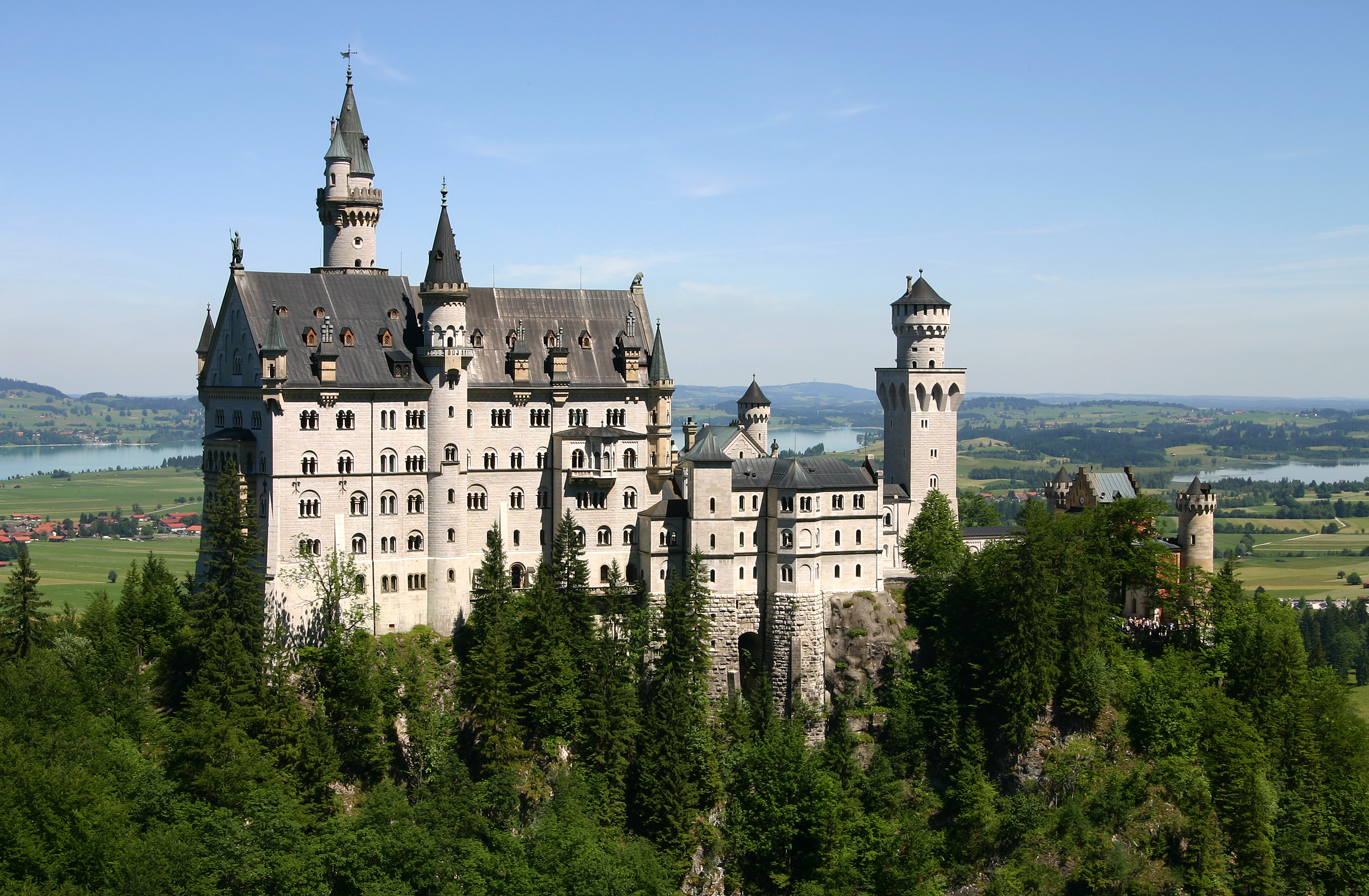
The castle comprises a gatehouse, a Bower, the
Knight's House with a square tower, and a Palas, or citadel, with two towers to
the Western end. The effect of the whole is highly theatrical, both externally
and within. The king's influence is apparent throughout and he
took a keen personal interest in the design and decoration. An example can be
seen in his comments, or commands, regarding a mural depicting Lohengrin in the
Palas; "His Majesty wishes that .. the ship be placed further from the shore,
that Lohengrin's neck be less tilted, that the chain from the ship to the swan
be of gold and not of roses, and finally that the style of the castle shall be
kept medieval." The castle includes a room made to look like a
cavern, as well as a secret flushing toilet in the master bedroom. The toilet
flushes with water collected from an aqueduct.

The suite of rooms within the Palas contains the Throne Room followed by Ludwig's suite, followed by the Singers' Hall and by the Grotto. Throughout, the design pays homage to the German legends of Lohengrin, the Swan Knight. Hohenschwangau, where Ludwig spent much of his youth, had decorations of these sagas. These themes were taken up in the operas of Richard Wagner. However, many of the interior rooms remain undecorated; only 14 rooms were finished before Ludwig's death
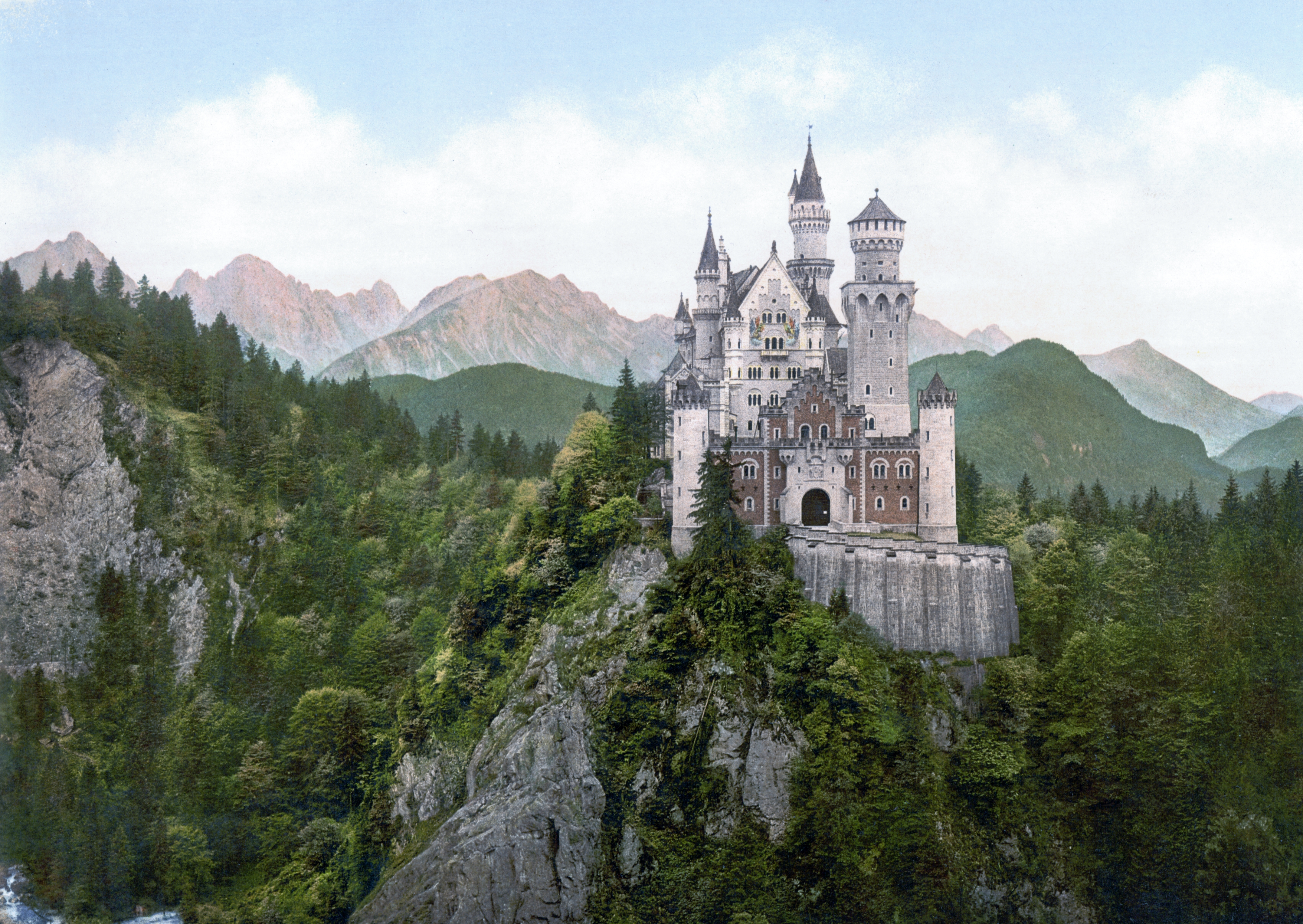
Despite its medieval look, the construction of Neuschwanstein required the modern technology of the day, and the castle is a marvel of technological structural achievements. Steam engines and electricity, modern venting, and heating pipes are all part of the structure.
It is now almost forgotten that Ludwig II was a patron of modern inventions and that he pioneered the introduction of electricity into public life in Bavaria. His new castles were the first to use electricity (i.e. the Venus Grotto at Linderhof) and other modern conveniences. Through his building activities Ludwig kept many particular crafts alive the knowledge and expertise of which would have died out otherwise, and he provided work and income to a large number of artisans, builders, plasterers, decorators, etc.

Neuschwanstein was close to completion when, in
1886, the King was declared insane by a State Commission under Dr. von Gudden
and arrested at the castle. The King could hardly control himself as he asked
von Gudden, "How can you declare me insane? You have not yet examined me!"
Taken to Schloss Berg, he was found on June 13, 1886, in shallow water in Lake
Starnberg, drowned, along with von Gudden, the psychiatrist who certified him.
The exact circumstances of his death remain unexplained.
The castle is owned by the state of Bavaria, unlike Hohenschwangau which is
owned by Franz, Duke of Bavaria. It inspired the building of another Wittelsbach
castle, Schloss Ringberg. Neuschwanstein is a contemporary of the slightly older
Portuguese Pena Palace in Sintra, sometimes referred to as 'the Portuguese
Neuschwanstein' (ca. 1840).
The nearby Marienbrücke (Mary's Bridge) over Pöllat Gorge, named after Marie of
Prussia, provides a view of one of Neuschwanstein's façades.
Neuschwanstein is to appear on a German Bundesländer series of €2 commemorative
coins in 2012.
In 2007, it was a finalist in the selection of the New Seven Wonders of the
World.

新天鹅堡(德语:Schloss Neuschwanstein)全名新天鹅石城堡,是19世纪晚期的建筑,位在今天的德国巴伐利亚西南方,邻近年代较早的高地天鹅堡(Schloss
Hohenschwangau,又称旧天鹅堡),距离富森(Füssen)镇约4公里,约在德国与奥地利边界不远处。
这座城堡是巴伐利亚国王路德维希二世的行宫之一。拥有360个房间,其中只有14个房间依照设计完工,其他的346个房间则因为国王在1886年逝世而未完成。是德国境内受拍照最多的建筑物[1]。也是最受欢迎的旅游景点之一。
历史
1890年代新天鹅堡正面的著色相片今天新天鹅堡(Schloss Neuschwanstein)和高地天鹅堡(Schloss Hohenschwangau)的所在地区,曾经在欧洲中古世纪建有四座古堡。不过到了19世纪,这些古堡已经是一片残垣断壁。其中一座称为“前天鹅石城堡”,在1830年代由马克西米利安二世(路德维希二世的父亲)所下令建造的“高地天鹅堡”取代。其西南方的另一座“女人石城堡”,也早已不复存在。剩下的两座,称为“前高地天鹅堡”和“后高地天鹅堡”,她们就在现今新天鹅堡所在的位置上。
路德维希二世决定在此地兴建他的“梦幻城堡”,因此下令将前后高地天鹅堡的废墟炸掉。在建立新天鹅堡的第一块基石的时候这些残垣断壁就已经被清除了。天鹅堡这个名字早在高地天鹅堡的前身已被使用,在十九世纪初,这个名字被继续引用到新建的城堡上,就是今天的新天鹅堡。
在1868年5月15在给作曲家瓦格纳的信中,国王路德维希二世提到希望在前高地城堡的古堡废墟上建筑一座中世纪的骑士城堡。给与他建堡启发的则是他父亲马克西米利安二世的早期建堡计划。另外一个更重要的启发则是他在1867年前往埃森纳赫Eisenach旅行中和弟弟奥托一世共同游览的瓦尔特堡。天鹅堡中的歌剧厅(Saengersaal)和骑士浴室(Ritterbad)的设计就采用了瓦尔特堡的设计图为蓝本。此外路德维希二世灵感还来源于西班牙摩尔人的建筑风格,以及对作曲家瓦格纳作品中的传说世界的幻想。城堡的设计草图由克里斯蒂安·扬克(Christian
Jank)设计。
国王路德维希最后在他自己建筑的新天鹅堡中的逗留是他在1886年6月9日被软禁时。在 他1886年6月13日死于SchlossBerg(am
Starnberger
See)时,新天鹅堡还没有完工。在17年的建筑时间里,他只逗留过172天。只有三分之一的房间在那个时候是完工的。国王路德维希从未想让新天鹅堡公诸于众,在他看来宁愿将此堡毁坏,也不能让它失去其神秘魅力。但是在他死后六个星期,城堡对外开放,并在旺季(六月到八月)接待每天达5000人。为了保证通顺的参观路线,一些房间在此后被完工。其中包括王位厅(Thronsaal)的带有巴伐利亚动物世界图案的马赛克地板。此地板有2百万块的小马赛克石组成,工程历时两年之久。
新天鹅堡奠基于1869年9月5日。从1869年至1873年新天鹅堡的大门部分的建筑和内部装饰完工。已便于路德维希临时居住和监察建筑的情况。1880年宫殿封顶庆典。1884年可以入住。国王的王位厅,餐厅,卧室,起居室,办公室
已经暖房。均设在城堡的第三层。为了方便建堡,城堡的第二层曾作为建筑工人的临时住所。路德维希的愿望和需求随着城堡的建筑不断的增长,王位厅取代了原先计划中的工作室,客人的房间则由摩尔厅所取代。但是由于资金的不足而没有实现。
这个城堡有传统的建筑用砖所建成,稍后由其他石材进行外部装裱。用于建筑大门和悬楼的砂层方石来自于巴登-符腾堡州的Nürtingen。用于建筑窗,穹弓,柱和祈祷堂的大理石来自于奥地利阿尔卑斯山脉的Unterberg。为了便于后来的王位厅曾动用的钢质的脚手架。值得一提的是,在王位的厅的正中央。大理石台阶的最上方,没有本来应该设置的王位宝座,因为路德维希二世从来就没有看到过和使用过这个王位厅。
影响
新天鹅堡的外型也激发了许多现代童话城堡的灵感,包括美国加州迪士尼乐园和香港迪士尼乐园的睡美人城堡。东京迪士尼乐园和美国佛罗里达州华特迪士尼世界中神奇王国的灰姑娘城堡的灵感是来自德国的一些城堡,尤其是Château
d'Ussé。
Mont Saint-Michel - Normandy, France
Mont Saint-Michel (English: Mount Saint Michael) is a rocky tidal island in Normandy, roughly one kilometre from the north coast of France at the mouth of the Couesnon River near Avranches. The inhabitants of Mont-Saint-Michel are called the Montois.
In prehistoric times the bay was land, as sea levels rose erosion shaped the
coastal landscape over millions of years. Several blocks of granite or granulite
emerged in the bay, having resisted the wear and tear of the ocean better than
the surrounding rocks. These included Lillemer, the Mont-Dol, Tombelaine and
Mont Tombe, later called Mont Saint-Michel.

Mont Saint-Michel was previously connected to the mainland via a thin natural
land bridge, which before modernization was covered at high tide and revealed at
low tide. Thus, Mont Saint Michel gained a mystical quality, being an island
half the time and being attached to land the other: a tidal island.
However, the insular character of the mount has been compromised by several
developments. Over the centuries, the coastal flats have been polderised to
create pasture. The south coast of Mont-Saint-Michel has thus become farther to
the shore and the mount. The Couesnon River has been canalised, reducing the
flow of water and thereby encouraging a silting-up of the bay. In 1879, the land
bridge was fortified into a true causeway. This prevented the tide from scouring
the silt round the mount. There are currently plans to remove the causeway and
replace it with a bridge and a shuttle.
On 16 June 2006, the Prime Minister of France, Dominique de Villepin, announced
a €150 million project (Projet Mont Saint-Michel) to build a hydraulic dam
that will help remove the accumulated silt and make Mont Saint-Michel an island
again. It is expected to be completed by 2012.
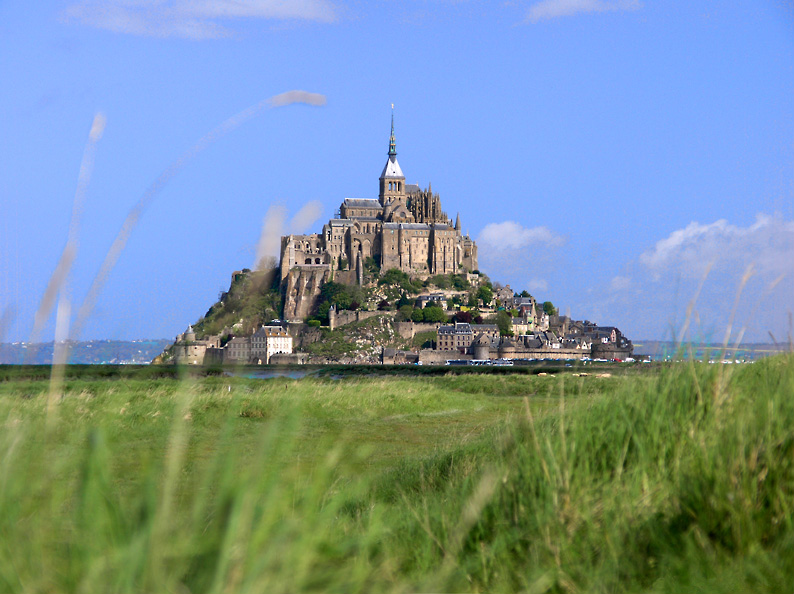
Mont Saint-Michel was used in the 6th and 7th centuries as an Armorican
stronghold of Romano-Breton culture and power, until it was ransacked by the
Franks, thus ending the trans-channel culture that had stood since the departure
of the Romans in AD 460.
Before the construction of the first monastic establishment in the 8th century,
the island was called Mont Tombe. According to legend, the archangel Michael
appeared to St. Aubert, bishop of Avranches, in 708 and instructed him to build
a church on the rocky islet. Aubert repeatedly ignored the angel's instruction,
until Michael burned a hole in the bishop's skull with his finger.
The mount gained strategic significance in 933 when William "Long Sword", Duke
of Normandy, annexed the Cotentin Peninsula, definitively placing the mount in
Normandy. It is depicted in the Bayeux Tapestry, which commemorates the 1066
Norman conquest of England. Ducal patronage financed the spectacular Norman
architecture of the abbey in subsequent centuries.
In 1067, the monastery of Mont Saint-Michel gave its support to duke William of
Normandy in his claim to the throne of England. It was rewarded with properties
and grounds on the English side of the Channel, including a small island located
at the west of Cornwall, which, modelled after the Mount, became a Norman priory
named St Michael's Mount of Penzance.
During the Hundred Years' War the English made repeated assaults on the island
but were unable to seize it partly due to the abbey's improved fortifications.
Les Michelettes, two wrought-iron bombards left by the English in their failed
1423–24 siege of Mont Saint-Michel, are still displayed near the outer defense
wall.

The wealth and influence of the abbey extended to many daughter foundations, including St Michael's Mount in Cornwall. However, its popularity and prestige as a centre of pilgrimage waned with the Reformation, and by the time of the French Revolution there were scarcely any monks in residence. The abbey was closed and converted into a prison, initially to hold clerical opponents of the republican régime. High-profile political prisoners followed, but by 1836 influential figures, including Victor Hugo, had launched a campaign to restore what was seen as a national architectural treasure. The prison was finally closed in 1863, and the mount was declared a historic monument in 1874. The Mont Saint Michel and its bay were added to the UNESCO list of World Heritage Sites in 1979, as they rank very high on such World Heritage Site criteria as cultural, historical, and architectural significance, as well as human-created and natural beauty.
圣米歇尔山(Mont-Saint-Michel)是法国诺曼底附近,距海岸约1公里的岩石小岛。地理坐标为 48°
38′ 8″ N, 1° 30′ 40″ W.
是法国旅游胜地,也是教徒的朝圣地,山顶建有着名的圣米歇尔修道院。圣米歇尔山及其海湾于1979年被联合国教科文组织列为世界文化及自然遗产。
修道院
圣米歇尔山夜景古时为凯尔特人祭神的地方。708年﹐阿夫朗什镇(Avranches)主教奥伯特(Aubert)遇天使长米歇尔显灵,并在其脑颅上点开一个洞,因此在岛上最高处修建一座小教堂,奉献给天使长米歇尔[1]﹐成为朝圣中心,故称米歇尔山。9世纪,维京人入侵欧陆,这里成为农民的避难所,修道院下方形成一个小镇。966年,诺曼底大公查理一世驱逐了里面的教士,代之以来自意大利卡西诺山修道院的30名本笃会修士。
1211年—1228年间,在岛北部又修建了一个以梅韦勒修道院为中心的6座建筑物﹐具有中古加洛林王朝古堡和罗马式建筑的风格。13世纪初,腓力二世
(法兰西)火攻圣米歇尔山,致使修道院北侧建筑严重损毁。同时诺曼底并入法国领土。战后法王拨资修建,在原有的罗曼式建筑之外加盖了哥特式建筑,使这里成为诺曼底境内最具规模的宗教建筑群,朝圣人数更盛。
1421年,罗曼式地下祭坛塌陷。英法百年战争后,复以火焰哥特式重建唱诗班席和圣坛。
1469年法王路易十一在此制定了圣米歇尔王诏。1622年,修道院中的教士遭到流放,取而代之的是圣本笃修会的一支圣摩尔(Saint-Maur)教团。
法国大革命时期,修士因不支持共和政府而遭到监禁,教会财产被拍卖,中殿被用来储存粮草。在这里囚禁过数以万计的罪犯和政敌。王政复辟后稍为恢复生机。
1874年,法国政府投入大笔经费进行为期百年的大规模复修工程。已筑起一条4公里长的堤道连接对岸陆地。岛上现还存有11世纪罗马式中殿和15世纪哥特式唱诗班席、13~15世纪的部分城墙和哥特式修道院围墙等。每年9月29日的圣米歇尔主保日举办庆祝活动。
自然景观
落潮时,小岛被泥沙包围(空中俯瞰)。小岛呈圆锥形﹐周长900米﹐由耸立的花岗岩构成。海拔88米﹐经常被大片沙岸包围﹐仅涨潮时才成为岛。圣马洛海湾涨潮迅猛,每逢傍晚,大西洋的潮水有如万马奔腾般扑过来,将山边的流沙淹没,圣山顿时变成汪洋,蔚为奇观。但十九世纪人们建筑长堤连接圣米歇尔山后,水流受阻,潮水的起落在沙地留下大量淤泥和沉积物,久而久之地势变高,岛的形状改变,海潮奇观亦随之消失。专家估计,到2042年,这座名山更将被杂草包围,大杀风景。
法国当局计划耗资逾二十亿港元进行修建,要将巨潮奇景重现眼前。
Prague Castle - Prague, Czech Republic
The Prague Castle (Czech: Pražský hrad) is the castle in Prague where the Czech kings, Holy Roman Emperors and presidents of Czechoslovakia and the Czech Republic have had their offices. The crown jewels of the Bohemian Kingdom are kept here. Prague Castle is one of the biggest castles in the world (according to Guinness Book of Records the biggest ancient castle) at about 570 meters in length and an average of about 130 meters wide.
The history of the castle stretches back to the 9th century (870). The first walled building was the church of Our Lady. The Basilica of Saint George and the Basilica of St. Vitus were founded in the first half of the 10th century. The first convent in Bohemia was founded in the castle, next to the church of St. George. A Romanesque palace was erected here during the 12th century. In the 14th century, under the reign of Charles IV the royal palace was rebuilt in Gothic style and the castle fortifications were strengthened. In place of rotunda and basilica of St. Vitus began building of a vast Gothic church, that have been completed almost six centuries later. During the Hussite Wars and the following decades the Castle was not inhabited.

In 1485 King Ladislaus II Jagello begins to rebuild the castle. The massive Vladislav Hall (built by Benedikt Rejt) was added to the Royal Palace. Then were also built new defence towers on the northern side of the castle. A big fire of 1541 destroyed large parts of the castle. Under Habsburgs some new buildings in renaissance style appeared here. Ferdinand I built Belvedere, summer palace for his wife Anne. Rudolph II used Prague Castle as his main residence. He founded the northern wing of the palace, with the Spanish Hall, where his precious artistic collections were exhibited. Second Prague defenestration in 1618 began the Bohemian Revolt.
During the subsequent wars the Castle was damaged and dilapidated. Many works from the collection of Rudolph II were looted by Swedes in 1648, in the course of the Thirty Years' War. The last major rebuilding of the castle was carried out by Queen Maria Theresa in the second half of the 18th century. Ferdinand V after abdication in 1848 chose Prague Castle as his home. In 1918 the castle became the seat of the president of the new Czechoslovak Republic. The New Royal Palace and the gardens were renovated by Slovenian architect Jože Plečnik.

During the Nazi occupation of Czechoslovakia during World War II, Prague Castle became the headquarters of Reinhard Heydrich, the "Reich Protector of Bohemia and Moravia". It is said that he placed the Bohemian crown on his head, believing himself to be a great king; old legends say that a usurper who places the crown on his head is doomed to die within a year. Less than a year after assuming power, Heydrich was assassinated.
After the liberation of Czechoslovakia, it housed the offices of the communist Czechoslovak government. During the Velvet Revolution, Alexander Dubček, the leader of Czechoslovakia during the Prague Spring, appeared on a balcony overlooking Wenceslas Square to hear throngs of protesters below shouting "Dubček to the castle!" As they pushed for him to take his seat as president of the country at Prague Castle, he embraced the crowd as a symbol of democratic freedom.

After Czechoslovakia split into the Czech Republic and Slovakia, the castle became the seat of the Head of State of the new Czech Republic. Similar to what Masaryk did with Plečnik, president Václav Havel commissionned Bořek Šípek to be the architect of post-communism Prague Castle's necessary improvements in particular of the facelift of the Castle's Gallery of paintings.
The castle buildings represent virtually every architectural style of the last millennium. The Prague Castle includes gothic St Vitus Cathedral, romanesque basilica of St. George, a monastery and several palaces, gardens and defence towers. Most of the castle areas are opened to the tourists.
Nowadays, the castle houses several museums, including the National Gallery collection of Bohemian baroque and mannerism art, exhibition dedicated to Czech history, Toy Museum and the picture gallery of Prague Castle, based on the collection of Rudolph II. Summer Shakespeare Festival regularly takes place in the courtyard of the Burgrave Palace.

布拉格城堡位于伏尔塔瓦河的丘陵上,已有1000多年历史,60多年来历届总统办公室均设在堡内,所以又称「总统府」,城堡包括以下部分。布拉格城堡画廊新近重新整建完毕的布拉格城堡画廊(Obrazarna Prazskeho Hradu)必须另外付费才可进入,其内收藏了许多古典绘画,最早从16世纪开始,而以16到18世纪绘画为主,涵括了义大利、德国、荷兰等各国艺术家作品,共有4,000馀幅。布拉格城堡画廊的原址是城堡马厩,在改建为城堡画廊的过程中,发掘出布拉格城堡最早的教堂-圣女教堂,部份遗迹存放在城堡画廊中。
圣维塔大教堂圣维塔大教堂(Katedrala sv. Vita)是布拉格城堡最重要的地标,除了丰富的建筑特色外,也是布拉格城堡王室加冕与辞世后长眠之所。圣维塔大教堂历经3次扩建,西元929年的圣温塞斯拉斯圆形教堂,在西元1060年时扩建为长方形教堂,西元1344年查理四世下令建造目前的哥德式建筑,却一直到西元1929年才正式完工。圣维塔大教堂的几个参观重点包括20世纪的彩色玻璃窗、圣约翰之墓和圣温塞斯拉斯礼拜堂。走进教堂入口,左侧色彩鲜丽的彩色玻璃就是布拉格着名画家穆哈的作品,为这个千年历史的教堂增添不少现代感;绕过圣坛後方,纯银打造、装饰华丽的是的圣约翰之墓,他是1736年的反宗教改革者,因此葬在圣维塔大教堂中,并以纯银华丽的装饰作为纪念。继续往前就是圣温塞斯拉斯礼拜堂,相较于前面纯银的圣约翰之墓,圣温塞斯拉斯礼拜堂呈现出金碧辉煌的光彩,从壁画到圣礼尖塔都有金彩装饰,相当具有艺术价值。从外观来看,哥德式的圣维塔大教堂有许多经典建筑特色,例如大门上的拱柱和飞扶壁,都装饰的相当华丽。旧皇宫旧皇宫(Stary Kralovsky Palac)是以往波西米亚国王的住所,历任在位者对不同部份进行修缮。整个皇宫建筑大致分为3层,入口一进去是挑高的维拉迪斯拉夫大厅,也是整个皇宫的重心,往上层的新领地大厅有许多早期书记的图像;下层有哥德式的查理四世宫殿,和仿罗马式宫殿大厅,大多数的房间在西元1541年的大火中受到毁坏,因此部份是后来重建的遗迹。
圣乔治教堂圣维塔大教堂(Bazilika sv. Jiri)後方有双塔的红色教堂就是圣乔治教堂,圣乔治教堂是捷克保存最好的仿罗马式建筑,920年完成后扩大修建多次,最近一次是在19世纪末20世纪初,教堂的基石和两个尖塔从10世纪一直保存至今。一旁的圣乔治女修道院是波西米亚第一个女修道院,曾在18世纪被拆除改建为军营,现在为国家艺廊,收藏14至17世纪的捷克艺术作品,包括哥德艺术、文艺复兴和巴洛克等不同时期的绘画作品。火药塔这里的火药塔(Prasna Vez-Mihulka)与旧城广场的火药塔一样,原本都是作为守城护卫的要塞,后来则为存放火药之用。16世纪时,国王让术士居住于此研究炼铅成金之术,18世纪后改为圣维塔大教堂储藏圣器的地方,现在则是展出中古艺术、天文学和炼金术文物的博物馆。黄金巷黄金巷(Zlata Ulicka)是布拉格古堡最着名的景点之一,观光客的拥挤程度与查理大桥不相上下,卡夫卡曾居住过的22号,目前是一家小巧可爱的书店,当然也贩售卡夫卡的作品集。黄金巷在圣乔治教堂与玩具博物馆之间,拐进一条小巷后到了这个小屋林立的黄金巷,宛如童话故事内的小巧房舍,是布拉格最诗情画意的街道。黄金巷原本是仆人工匠居住之处,后来因为聚集不少为国王炼金的术士,因而有此名称,然而在19世纪之后,逐渐变成贫民窟。 20世纪中期重新规划,将原本的房舍改为小店家,现在每家商店内可看到不同种类的纪念品和手工艺品,例如16号的木制玩具、20号的锡制布拉格小士兵、21号的手绘衣服,19号的外观最有看头,是花木扶疏的可爱花园小屋。
Lincoln Castle - Lincolnshire, England
Lincoln Castle is also the name of a paddle steamer which
served as a ferry on the River Humber. Lincoln Castle is a major castle
constructed in Lincoln, England during the late 11th century by William the
Conqueror on the site of a pre-existing Roman fortress. When William the Conqueror defeated Harold and the English at Hastings on the
14th October 1066 he continued to face resistance to his rule in the north of
England. For a number of years William's position was very insecure and in order
to project his influence northwards to control the 'Danelaw' (an area
traditionally under the control of Scandinavian settlers) he felt it necessary
to construct a number of major castles in the north and midlands of England. It
was at this time that the new King built major castles at Warwick, Nottingham
and York. After gaining control of York, the Conqueror turned southwards and
arrived at the Roman and Viking city of Lincoln.
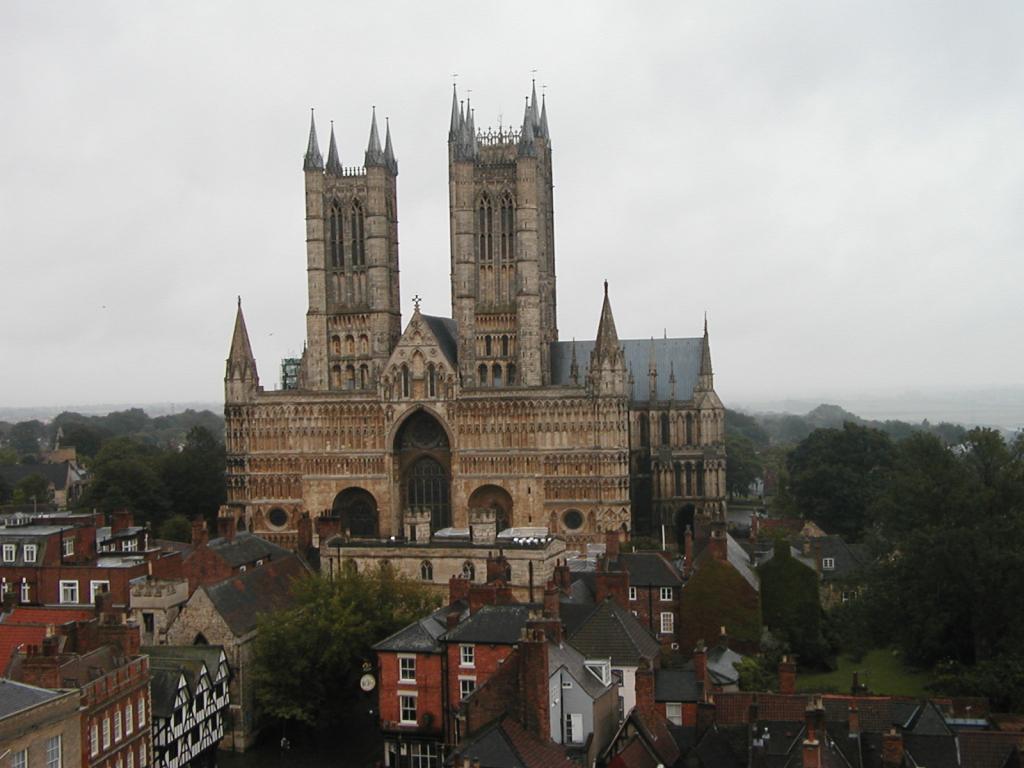
When William reached Lincoln (one of the country's major settlements) he found a
Viking commercial and trading center with a population of 6,000 to 8,000. The
remains of the old Roman walled fortress located 60 meters (200 ft) above the
countryside to the south and west, proved an ideal strategic position to
construct a new castle. Also, Lincoln represented a vital strategic crossroads
of the following routes (largely the same routes which influenced the siting of
the Roman fort). The Ermine Street - a major Roman road and the Kingdom's principal north-south
route connecting London and York.
The Fosse Way - another important Roman route connecting Lincoln with the city
of Leicester and the south-west of England
The Valley of the River Trent (to the west and southwest) - a major river
affording access to the River Ouse, and thus the major city of York.
The River Witham - a waterway that afforded access to both the Rivers Trent (via the Fossdyke Roman canal at Torksey) and the North Sea via The Wash.
The Lincolnshire Wolds - an upland area to the northeast of Lincoln, which
overlooks the Lincolnshire Marsh beyond.
A castle here could guard several of the main strategic routes and form part of
a network of strongholds of the Norman kingdom, in Danish Mercia, roughly the
area of the country that is today referred to as the East Midlands, to control
the country internally. Also (in the case of the Wolds) it could form a center
from which troops could be sent to repel Scandinavian landings anywhere on the
coast from the Trent to the Welland, to a large extent, by using the roads which
the Romans had constructed for the same purpose.
The castle was built in the south-west corner of the upper walled town, the
remainder of which was occupied by the town. The Domesday Book entry for Lincoln
records that of the 1164 residences in the city, 166 were demolished to make way
for the castle. Of the 1164 pre-Conquest residences, perhaps 600 will have been
in the upper town. Before long, more was taken up when the cathedral and its
close were placed there.
Work on the new fortification was completed in 1068. It is probable that at
first a wooden keep was constructed which was later replaced with a much
stronger stone one. Lincoln castle is a little unusual in having two mottes. To
the south, where the Roman wall stands on the edge of a steep slope, it was
retained partially as a curtain wall and partially as a revetment retaining the
mottes. In the west, where the ground is more level, the Roman wall was buried
within an earth rampart and extended upward to form the Norman castle wall. The
Roman west gate (on the same site as the castle's westgate) was excavated in the
19th century but collapsed on exposure.
Chateau de Chambord - Loire Valley, France
The royal Château de Chambord at Chambord, Loir-et-Cher, France, is one of
the most recognizable châteaux in the world because of its very distinct French
Renaissance architecture that blends traditional French medieval forms with
classical Italian structures.
It is the largest castle in the Loire Valley, but was built to serve only as a
hunting lodge for King François I, who maintained his royal residences at
Château de Blois and at Château d'Amboise. The original design of the Château de
Chambord is attributed, though with several doubts, to Domenico da Cortona,
whose wooden model for the design survived long enough to be drawn by André
Félibien in the seventeenth century. Some authors, though, claim that the
renaissance french architect Philibert Delorme had a considerable role in the
Château's design. Chambord was altered considerably during the twenty
years of its construction (1519 ‑ 1547), during which it was overseen on-site by
Pierre Nepveu. In 1913 Marcel Reymond first suggested that Leonardo da Vinci,
a guest of King François at Clos Lucé near Amboise, was responsible for the
original design, which reflects Leonardo's plans for a château at Romorantin for
the King's mother, and his interests in central planning and double helical
staircases; the discussion has not yet concluded. Nearing completion, King
François showed off his enormous symbol of wealth and power by hosting his old
enemy, Emperor Charles V at Chambord.

The massive castle is composed of a central keep with
four immense bastion towers at the corners. The keep also forms part of the
front wall of a larger compound with two more large towers. Bases for a possible
further two towers are found at the rear, but these were never developed, and
remain the same height as the wall. The castle features 440 rooms, 365
fireplaces, and 84 staircases. Four rectangular vault hallways on each floor
form a cross-shape.
The elaborately decorated roof line, The roofscape of Chambord contrasts with the
masses of its masonry and has often been compared with the skyline of a town: it
shows eleven kinds of towers and three types of chimneys, without symmetry,
framed at the corners by the massive towers. The design parallels are north
Italian and Leonardesque. One of the architectural highlights is the spectacular
double-helix open staircase that is the centrepiece of the castle. The two
helixes ascend the three floors without ever meeting, illuminated from above by
a sort of light house at the highest point of the castle. There are suggestions
that Leonardo da Vinci may have designed the staircase, but this has not been
confirmed.
The castle also features 128m of façade, more than 800 sculpted columns and an
elaborately decorated roof. When François I commissioned the construction of
Chambord, he wanted it to look like the skyline of Constantinople.
The castle is surrounded by a 52.5‑km² (13,000‑acre) wooded park and game
reserve maintained with red deer, enclosed by a 31‑kilometre (20‑mile) wall.
The château was never intended to provide any form of defense from enemies. As
such, the walls, towers and partial moat are purely decorative, and even at the
time were an anachronism. Elements of the architecture - open windows, loggia,
and a vast outdoor area at the top - were also borrowed from the Italian
renaissance style, which made them out of place in colder central France.
The design and architecture of the château inspired William Henry Crossland for
his design of what is known as the Founder's building at Royal Holloway,
University of London. The Founder's building features very similar towers and
layout but was built using red bricks.
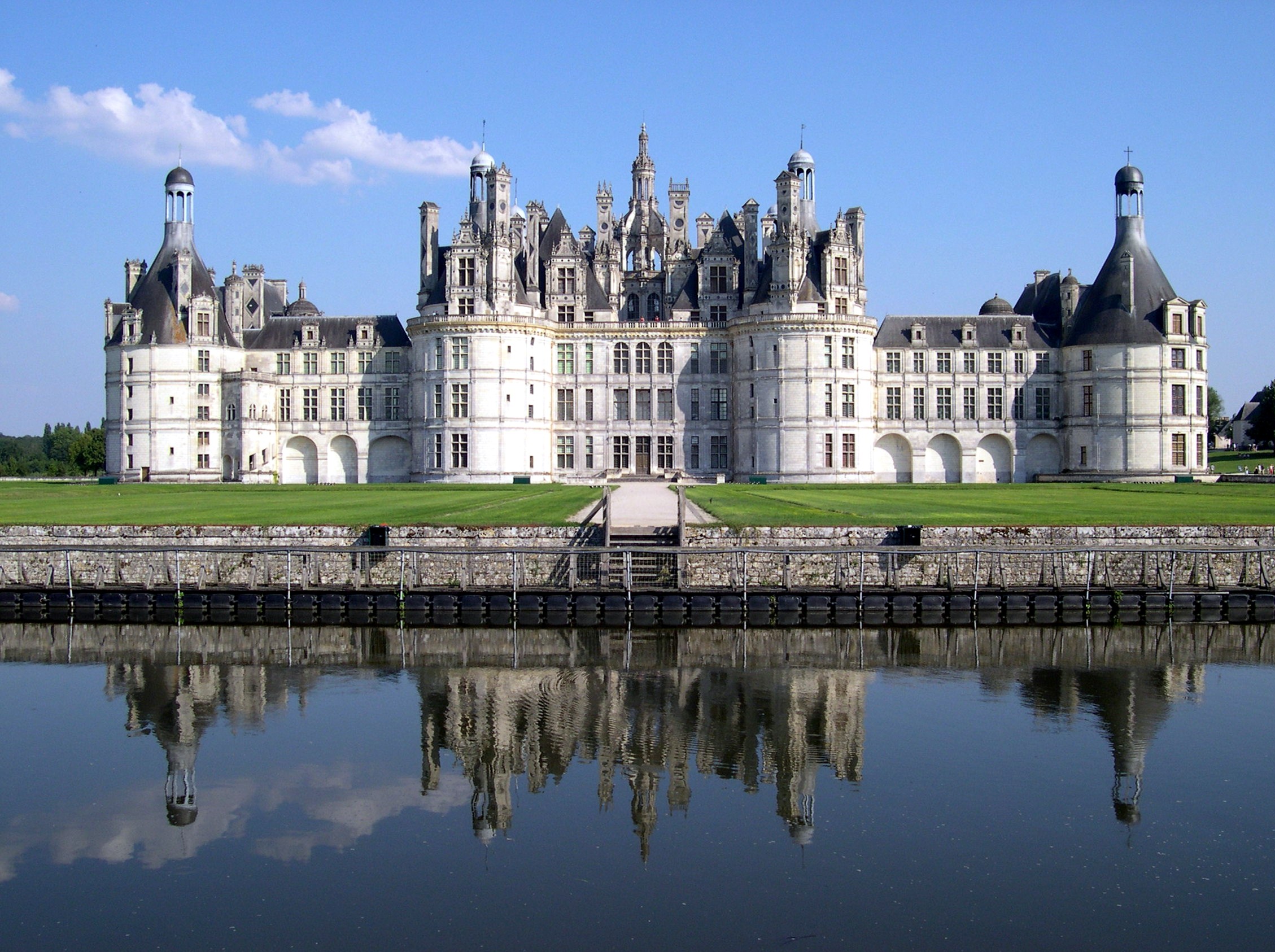
During François I's reign, the castle was rarely
inhabited. In fact, the king spent barely 7 weeks there in total, comprised of
short hunting visits. As the castle had been constructed with the purpose of
short visits, it was actually not practical to live there on a longer-term
basis. The massive rooms, open windows and high ceilings meant heating was
impractical. Similarly, as the castle was not surrounded by a village or estate,
there was no immediate source of food other than game. This meant that all food
had to be brought with the group, typically numbering up to 2000 people at a
time.
As a result of all the above, the castle was completely unfurnished during this
period. All furniture, wall coverings, eating implements and so forth were
brought specifically for each hunting trip, a major logistical exercise. It is
for this reason that much furniture from the era was built to be disassembled to
facilitate transportation. He died of a heart attack in 1547.
Louis XIV
For more than eighty years after the death of King François, French kings all
but abandoned the castle, allowing it to fall into decay. Finally, in 1639 King
Louis XIII gave it to his brother Gaston d'Orleans who saved the castle from
ruin by carrying out much restoration work. King Louis XIV had the great keep
restored and furnished the royal apartments. The king then added a 300-horse
stable, enabling him to use the castle as a hunting lodge and a place to
entertain such notables as Molière for a few weeks each year. Nonetheless, Louis
XIV abandoned the castle in 1685.
Louis XV
From 1725 to 1733, Stanislas I (Stanislas Leszczynski), the deposed king of
Poland and father-in-law of King Louis XV, lived at Chambord. In 1745, as a
reward for his fighting valor the king gave the castle to Maurice de Saxe,
Marshal of France who installed his military regiment there. Maurice de Saxe
died in 1750 and once again the colossal castle sat empty for many years.

In 1792, the Revolutionary government ordered the sale of
the furnishings; the wall panellings were removed and even floors were taken up
and sold for the value of their timber, and, according to M de la Saussaye,
the panelled doors were burned to keep the rooms warm during the sales; the
empty castle was left abandoned until Napoleon Bonaparte gave the castle to
French military leader Louis Alexander Berthier. The castle was subsequently
purchased from his widow for the infant Duke of Bordeaux, Henri Charles
Dieudonné (1820-1883) who took the title Comte de Chambord. A brief attempt at
restoration and occupation was made by his grandfather King Charles X
(1824-1830) but in 1830 both were exiled. During the Franco-Prussian War,
(1870-1871) the castle was used as a field hospital.
The Ducal family
The final attempt to make use of the colossus came from the Comte de Chambord
but after the Comte died in 1883, the castle was left to his sister's heirs, the
Ducal family of Parma, Italy. Firstly Robert, Duke of Parma who died in 1907 and
after him, Elias, Prince of Parma. Any attempts at restoration ended with the
onset of World War I in 1914.
Modern history
In 1939, shortly before the outbreak of World War II, the art collections of the
Louvre and Compiègne museums (including the Mona Lisa and Venus de Milo) were
stored at the Château de Chambord. An American bomber plane crashed onto the
castle lawn on June 22, 1944.
The castle became the property of the Government of France in 1930 but
restoration work was not begun until a few years after World War II ended in
1945. Today, Chambord is a tourist attraction but unfortunately is not
profitable
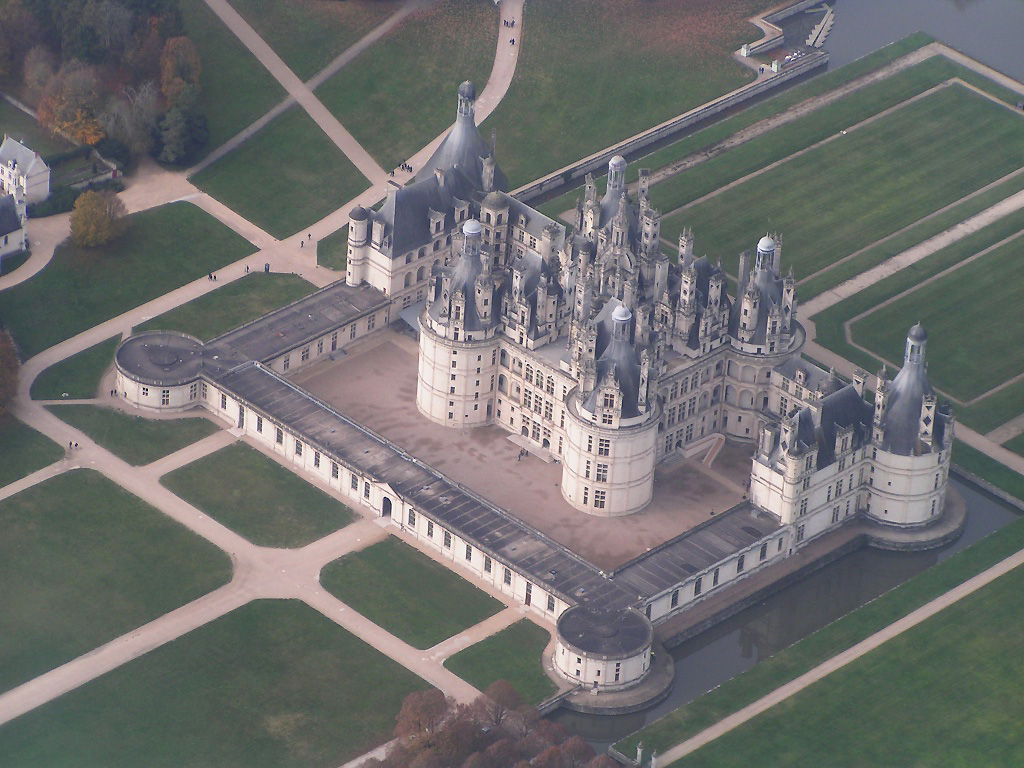
尚博尔城堡坐落在卢瓦尔河谷大森林中部的尚博尔庄园及城堡是法国文艺复兴时期建筑风格无与伦比的杰作。它以极具想象力的方式把中世纪传统建筑模式和古典意大利式结构奇妙地结合在一起。
尚博尔城堡,位于法国中部的尚博尔市内,坐落在卢瓦尔河左岸的科松镇,其以历史久远、结构繁复而闻名于世。尤其是螺旋式阶梯的纪念塔,具有很高的历史价值。
尚博尔城堡于1519年开始修建,面积约52平方千米。有长32千米的城墙以及6座城门。尚博尔城堡由两部分组成。其一是长156米、宽117米四角都建有圆形塔楼的长方形墙堡,其二是四角建有方形角楼的一座长方形楼房,旁边还有纪念塔。分为三层的纪念塔,每层都有平台。另外,在两者之间还排列着千座塔楼。
尚博尔城堡的建造者是弗朗索瓦一世。城堡的东殿曾是他的居所,现今还保存着的还有他的祈祷室。
坐落在卢瓦尔河谷大森林中部的尚博尔庄园及城堡,从正面看,是一个中央聚集了许多修长的小塔的组合体,两边各一个大角堡使它显得稳当稳固。尚博尔的最高处距地面128米,是城堡的主楼,四个角堡为小圆堡围着主楼。城堡内共设有440间房,365个壁炉。每天点一个壁炉,每个壁炉一年只用一次。法兰西斯一世是文艺复兴运动的热情追随者,他有文化修养、有军事才能、有治国宏略,他迷上了龙巴托式的建筑风格,加之对狩猎的狂热爱好,因此决定建尚博尔。1517年,达芬奇被邀请到法国宫廷,为尚博尔的建筑方案绘制了几幅草图,法兰西斯一世十分满意,结合这几张草图他又要求其他建筑师进行了完整的设计计划。1519年,城堡的建筑正式开始。花费了15年的时间,其中央部分完成了。城堡的占地面积宽阔,一半用来当作花园,一半是森林,为此国王购下了附近的大片土地。
附近无边的森林与从这里蜿蜒流过的卢瓦尔河一起构成了它特有的风光,是当时全法国野生动物最多的区份之一,因而成为贵族们狩猎的黄金地段。昔日王亲贵族狩猎之地如今成了香博尔公园,它是欧洲最大的公园,占地5433公顷,周长32公里的围墙至今坚固如初,公园里的4000公顷森林属国家级狩猎区。
尚博尔城堡是属文艺复兴风格的建筑,但那挺拔轻盈的密集塔尖和拱顶却处处洋溢着哥特艺术的气息。城堡筑在一个长方形地基上,塔楼处于城堡中央的主体部分。法兰西斯一世的套房设在主塔楼左侧的位置——大角堡的二层楼上,与之对称的另一个角堡是一个小礼拜堂。城堡内部最令人赞叹的是主厅里的两组螺旋形楼梯,每组楼梯围绕着自身的中轴线向上盘旋,它的妙处在于两个同时上下楼的人永远不会碰面。当时,为了这座宏伟的行宫,法兰西斯一世不惜砍掉了两片著名的森林,作为最初的基金,他还滥用权力,强行调动教会的财富用来建堡。法兰西斯一世奠下了这个城堡的基石,但却没有圆了自己的梦。他去世时城堡的主楼虽已完成,但离整个城堡彻底竣工还相距甚远。直至150年后,才由路易十六将它彻底建成。法国历史上的许多重要人物都在尚博尔留下了印迹。
法国大革命后,城堡遭受了多次抢劫,无数珍贵的文物和艺术品被洗劫,城堡先是沦为养马场,后又成为火药工厂,最后变成了关押犯人的牢狱。共和国建立以后,这里被重新修复。
Glamis Castle - Glamis, Scotland
Glamis Castle is situated beside the village of Glamis —
pronounced Glahmz — in Angus, Scotland. It is the home of the
Earl and Countess of Strathmore, and is open to the public. Glamis Castle was
the childhood home of Elizabeth Bowes-Lyon, best known as the Queen Mother. Her
daughter, Princess Margaret, was born there. A picture of the castle is featured
on the Royal Bank of Scotland ten pound note.
The plasterwork ceilings of Glamis are noteworthy for their detail and
preservation. Along with those of Muchalls Castle and Craigievar Castle, they
are considered the finest in Scotland.
The castle features extensively in fiction and legend, and according to local
legend has more dark secrets than any other castle in Britain.

Glamis is set in the fertile lowland valley of
Strathmore, which lies between the Sidlaw Hills to the south and the Grampian
Mountains to the north, approximately 20 kilometres inland from the North Sea.
The estate surounding the Castle covers more than 14,000 acres (57 km²) and, in
addition to containing lush gardens and walking trails, produces several cash
crops including lumber and beef. The two streams run through the estate, one of
them the Glamis Burn. An arboretum overlooking Glamis Burn features trees from
all over the world, many of them rare and several hundred years old. Birds and
other small wildlife are common throughout the grounds.

There is a tea room in the Castle, and part of the gardens and grounds are open
to the public. The building can be hired for functions like dinners and
weddings.
格拉姆斯堡伟然矗立于苏格兰草原与森林之间,诺曼底式的角楼将古典的苏格兰塔楼围起,兼有法国与苏格兰的建筑风格,其家族徽志是两只动物交缠在一起的巨石像,也象征了1200年前基督教与异教在苏格兰的际会。令世人难忘的是莎士比亚从这里幽微的鬼魂传奇中,得到源源不绝的灵感,写下四大悲剧之一“麦克白”的巨作。
Leeds Castle - Kent, England
Leeds Castle, four miles south east of Maidstone, Kent,
England, dates back to 1119, though a manor house stood on the same site from
the ninth century. The castle and grounds lie to the east of the village of
Leeds, Kent, which should not be confused with the city of Leeds in West
Yorkshire.

Built in 1119 by Robert de Crevecoeur to replace the
earlier Saxon manor of Esledes, the castle became a royal palace for King Edward
I of England and his queen, Eleanor of Castile in 1278. Major improvements were
made during his time, including the Barbican, made up of three parts, each with
its own entrance, drawbridge, gateway, and portcullis. The medieval keep is
called the "Gloriette" in honour of Queen Eleanor.
In 1321 King Edward II besieged the castle after his queen was refused
admission, and used ballistas, or springalds, to force its defenders to
surrender. Richard II's first wife, Anne of Bohemia, spent the winter of 1381 at
the Castle on her way to be married to the King, and in 1395, King Richard II
received the French chronicler Jean Froissart there, as Froissart described in
his Chronicles.

Henry VIII transformed the castle for his first wife,
Catherine of Aragon, and a painting commemorating his meeting with Francis I of
France still hangs there. His daughter, Queen Elizabeth I was imprisoned in the
castle for a time before her coronation.
The castle escaped destruction during the English Civil War because its owners,
the Culpeper family, sided with the Parliamentarians. The last private owner of
the castle was the Hon. Olive, Lady Baillie, a daughter of Almeric Paget, 1st
Baron Queenborough, and his first wife, Pauline Payne Whitney, an American
heiress. Lady Baillie bought the castle in 1926. She redecorated the interior,
first working with the French architect and designer Armand-Albert Rateau (who
also oversaw exterior alterations as well as added interior features such as a
16th-century-style carved-oak staircase) and then, later, with the Paris
decorator Stéphane Boudin. Baillie established the Leeds Castle Foundation. The
castle was opened to the public in 1976.

On 17 July 1978, the castle was the site of a meeting
between the Egyptian President Anwar Sadat and Israeli Foreign Minister Moshe
Dayan in preparation for the Camp David Accords.
In September 1999, Sir Elton John played two sold-out solo concerts in the
grounds of Leeds Castle.

利兹堡位于英格兰肯特郡梅德斯顿以东4英里处的梦幻的伦河(LEN)河谷中。整个城堡位于一个小湖的中央秀美的河水,显得十分优雅。最早的利兹堡建造于公元857年,是在木结构城堡基础上建造的,当时名为Esdeles。
清晨的阳光,照亮了肯特乡间的宁静湖面,也唤醒了湖边美丽的城堡。难以想象,这座城堡已经有上千年的历史。它曾是英国皇室的乡间别墅,深受王后们的宠爱,因此被称为“王后的城堡”,它在英国历史和建筑史上享有盛名,因此又被誉为“城堡中的王后”。
利兹堡兴建的具体年份已无从考证。人们只知道:13世纪,它正式成为皇家别墅。当时皇室的一个习俗就是:历代新任国王把利兹堡送给王后享用。所以,后人评价说:利兹堡里的一切都有浓厚的女性气息,不愧为女王的城堡。后来,在都铎王朝亨利8世的手中,利兹堡重新为私人所有。直到500多年以后,也就是25年前,利兹堡正式对外开放,每年接待50多万游客。
与其说游客来这儿是为了欣赏历史悠久的古建筑,还不如说为了感受皇家别墅的奢华与气派。这是一间王后住过的卧室,属于15世纪风格。这是亨利8世举行舞会的大厅,也是城堡中最大的房间。这种16世纪法国壁毯和法式壁炉如今已经非常罕见。墙上挂着皇室成员的肖像,历经多年仍保持完好。
在2400多棵杉树组成的迷宫里,不少游客需要指点才能找到出口。利兹堡中还有一个独一无二的博物馆:狗项圈博物馆。记载了400多年中狗项圈的变化和发展。就在今天,这里仍保持着当年皇室留下的珍禽园。喂养着100多种英国本土没有的鸟儿。
城堡的葡萄园在一本1086年完成的历史书中就曾被提及。这里自制的葡萄酒曾是皇室钟爱的佳酿。欣赏着利兹堡的风景、品尝着上好的葡萄酒,游客们说:皇室的享受也不过如此吧。
幸运的话,你还会看到黑天鹅
1119年城堡才由木构改为石制,而且为当时盛行的罗曼式,自12世纪初建造完成以来,这里一直有人居住。1278年,希望得到当时的国王爱德华一世宠信的朝臣将利兹城堡献给了这位国王。从此开始,利兹城堡与皇室结下了不解之缘,并且一直作为皇室最信赖的避难所。凑巧的是多数来此避难的都是皇室中的女性,14世纪在爱德华二世被刺杀后,皇后便来此居住,一直到她去世;而亨利八世的第一位王后离婚后也居住在这里。除了这两位外,还有
四位皇室女性在这里长住,所以人们又习惯的称利兹城堡为“女士城堡”。受到这样的宠幸,利兹城堡前后经过了无数次的改建和增建。
亨利八世时代,国王为了躲避伦敦的瘟疫而来到了这里,并且喜欢上了这里,于是出钱把它改造成为更为华丽的皇家行宫。走进城堡里仔细游览,往昔的皇家的奢靡随处可见,绝对是一个感受和解读英国历史的好去处!知道1552年,爱德华六世将城堡赐予了圣雷捷爵士,以奖励他在平定爱尔兰时所立下的赫赫战功,笼罩在利兹城堡300年的皇族光环才渐渐隐去。到了20世纪30年代,这里被贝莉夫人买了下来,并进行了又一次的改造。如今的利兹城堡一身清风,飘逸灵秀,城堡周围是大片的草坪,成片的鲜花在风中摇曳,四面的湖水清澈而平静,幸运的话还可以看到珍稀的黑天鹅,所有的一切都使得城堡显得梦幻而美丽,难怪能得到“世界上最可爱的城堡”的美名。
现在的整个利兹城堡主要分为两个整体,一部分是城堡的建筑,保存着中世纪时候作为防御工事的建筑,城堡的主体是主人活动的主要场所,卧室、会客厅、宴会厅、图书室等都对公众开放,特别是都铎样式的宴会厅中装饰华丽,至今依然带着亨利八世时的皇家气派,墙上依然挂着精美的壁毯,还有美仑美奂的家具以及各类艺术品和收藏品,精致的壁炉上悬挂着亨利八世的画像。
另一部分是后来逐渐增建的那一部分,主要是后来的城堡主人根据自己的喜好而增建的,位于城堡所处湖泊的东侧,包括巨大的迷宫、鸟舍、草药园、观景台。





It is delighted to share appreciation with a friend like you. I know there are many castles scattered around England and I will definitely have a close look later on.
Thank you so much for the sharing! Take care.
Thank you so much for the visiting. I am glad you like it. I heard of Versaille and will check it out when I get around. Thank you again for the info.
谢谢你的分享! 歌曲是 "Besame Mucho 歌手是 Andrea Bocelli。一下是download地址。
http://failover2.cdn.hinet.net/xuite/2/2/0/0/14757437/blog_271996/dv/5856442/5856442.wma
Glad you did the tour! And, I have to say, what an association you have to think about princess & prince. It is indeed a fairyland. I saw the movie, too. Enjoyed it very much.
Thanks!
thanks again for these wonderful photos and charming musique
I saw a movie "under the Tuscan sun" several years ago. Still remember Tuscan was a very quiet and pretty place.
The castles you posted here reminded me of an imprisoned princess, handsome price charming and an old ugly witch. Haha...still dreaming, LOL
The music is enjoyable too, matches with the whole post.